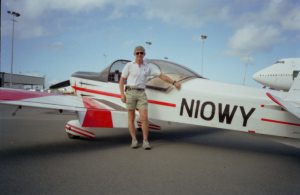
Treasure Hunt #1
Winner: Keith Douglas Craig of Pearl City, HI
Number of Correct Answers: 6, but only 5 delivered before contest closing
Answers were due by midnight, May 7, 2001
This week's prize:

One Hour of Dual Aerobatic Instruction in Cap
10 with Hank Bruckner
Every pilot can benefit from aerobatics, but only a few learn this
essential art. Should you ever end up on your back, due to wake turbulence
or any other reason, lessons learned in an aerobatic safety course could
save your life. The average pilot will pull back when caught upside down,
reaching speeds approaching or exceeding redline and losing thousands
of feet. The acro pilot will likely roll the plane, adding top rudder
to keep nose from falling and recovering with much less altitude loss.
Win this week's contest, and an hour of dual is yours!
Challenge:
Answer the following two questions. See the rules
page learn how to send your answers in. See the prizes
page to check out all contest prizes. Good luck!
The year was 1925, and a little-known aviator named Charles Lindbergh
still flew mail between St. Louis and Chicago. A major event was shaping
up in the Pacific, however. The U.S. Navy announced that it would fly
non-stop from California to Hawaii. Never mind that the planes involved
could not reach Hawaii in calm winds, the Navy would enlist the assistance
of northeast trade winds. A fleet of vessels stretched from the coast
to the islands at two hundred mile intervals.
Two PN-9 flying boats departed California
and headed southwest. One encountered problems and set down next to a
ship. The other continued into the night. With fuel running low, the commander
of the PN-9 requested radio position finding from the closest naval ship.
The plane turned north, as directed, and with no ships in sight and fuel
depleted, the crew managed a successful water landing. When meteorolgical
conditions allowed the PN-9 crew to determine their position, they realized
they were far north of course and the naval vessels would be searching
south of course.
First Question: Who was the commander
of the PN-9 which flew through the night?
Second Question: What amazing action
did the crew of this flying boat take to facilitate their eventual rescue?
First Answer: John Rodgers
Second Answer: The crew removed fabric from the lower wing to rig
sails between the two wings. They then sailed the plane to Kauai! It took
about ten days to reach the islands. Originally they tried for Oahu, but
with limited steering ability the decision was made to change destination
to Kauai. A submarine spotted the plane offshore Kauai. If not spotted,
the crew intended to sail into Nawiliwili Harbor the next morning.
John Rodgers and his crew received a hero's welcome. The airport now
known as Honolulu International originally took the name John Rodgers
Field, in honor of the aviator. As Hawaii slowly forgot this incredible
feat, the Rodgers name was dropped, and instead the terminal building
was named for him. More recently, the name John Rodgers Field was used
along with Hawaiian name Kalaeloa when referring to the former Barber's
Point Naval Air Station. So, when you see the initials JRF used for Kaleloa,
think of five brave Navy men sailing a seaplane across the Pacific.
 The John Rodgers PN-9 in Nawiliwili Harbor. Notice metal planks strapped
to mid fuselage to act as a keel for enhanced steering. Fabric sails already
taken down.
The John Rodgers PN-9 in Nawiliwili Harbor. Notice metal planks strapped
to mid fuselage to act as a keel for enhanced steering. Fabric sails already
taken down.
Further Reading? Try No Margin for Error
by Dwight Messimer, Naval Institute Press 1981